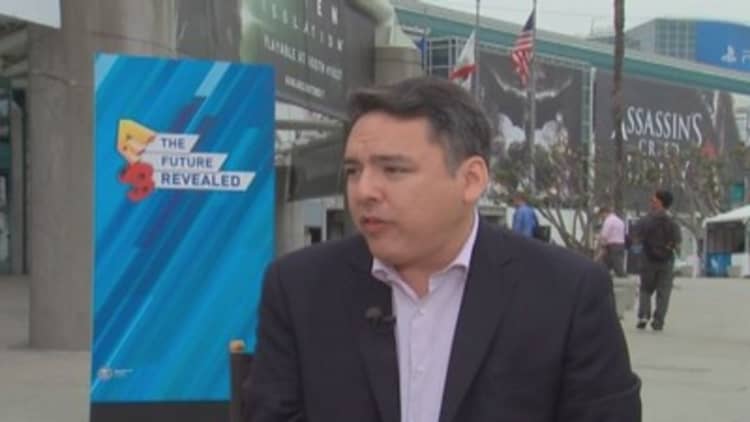One year ago, Ouya seemed poise to change the gaming world.
The console was a crowdfunding sensation. Having raised $8.6 million on Kickstarter in late 2012, its success attracted the notice of noted venture capitalists (Kleiner Perkins was among the firms that took part in a subsequent $15 million fundraising). With its $99 price tag, the Android system seemed poised to shake up the hierarchy of the console world. And that's why it was one of two gaming companies named to CNBC's 2013 Disruptor 50 list.
Today, Ouya's conquest of the console market is all but dead. The hardware is still available, but the company seems to be pinning its hopes on a new strategy as a software platform, with hopes of striking a deal to be embedded into televisions and set-top boxes.
What happened to this once promising company? Put simply: Ouya made just about every possible mistake a gaming start-up can make—and invented a few new ones along the way.
The system received terrible reviews. Game makers complained they made next to nothing on game sales. There was a paucity of exclusive titles in its early days. There were no initial parental controls to enable parents to prevent kids from playing games they felt are inappropriate. The company chose not to work with the ESRB, the video game ratings board. And CEO Julie Uhrman regularly failed to answer questions about how Ouya would be compliant with the Children's Online Privacy Protection Act (COPPA).
Read More Console makers get back to basics: Making games
And, in a humiliating capper, several people who backed the project on Kickstarter didn't receive their consoles until after the retail launch. (Some, judging by comments on that Kickstarter page, still haven't received their systems—despite a vow by Uhrman 11 months ago that the issue would be addressed.)
[Players] shift around like flocks of locusts in the mobile space—and stay until something else fun pops up.John Taylormanaging director and video game analyst at Arcadia Investment
"We have done a lot of things wrong," Uhrman said at the XOXO technology festival last October. "We've made a lot of mistakes. And I think one thing that's really unique about us is that we're gonna continue to make them."
John Taylor, managing director and video game analyst at Arcadia Investment, summed up the company's problems by saying Ouya "lacked the capital, business model and games lineups required to build a scale audience."
While there are plenty of Ouya doubters, Uhrman is still bullish on the console and categorizes the move to a software platform as an expansion in strategy, not a shift. And though the company has not released any sales figures for its hardware, she notes that the number of games has expanded greatly.
Read MoreVirtual reality is gaming's future, even if it's a little strange
"It's been a great year," Uhrman said at the recently concluded E3 trade show. "We have a great product in the marketplace. When we launched a year ago, we had 160-some-odd games. Today we have over 820. … We've extended our business model to embed our platform on other devices. We'll continue to make the Ouya [console], which is the best reference device for our gamers and developers, but we didn't want to lock our content just to our device. "
Ouya made a bet that gamers and developers would embrace its strategy because it challenged the high-priced model of the console kings, which does not allow a game to be sampled before purchase for as much as $60. Not only did the mass exodus not happen, but one of the two status-quo gaming kings, , just announced plans at E3 to renew its focus on core games for the console, launching a dozen new titles.
The story's different at Kabam, the other gaming entry on the 2013 CNBC Disruptor 50 list.
While Kabam didn't make the 2014 CNBC Disruptor 50 list, it hasn't run into the issues that dragged down Ouya. The company received an additional round of funding from Google Ventures last fall and is considered a likely IPO candidate. It has raised $125 million from investors in all, and its 2013 revenue doubled to more than $360 million. (It expects to generate between $550 and $650 million in 2014.)
It's been another year of growth, though, without any major breakthroughs—Kabam didn't create a new market or ecosystem this year, but it did acquire competitor Phoenix Age, which specializes in role-playing mobile games. And it opened an office in Berlin that's expected to employ 150 people by the end of this year.
Read MoreZynga's improbable road back from gaming roadkill
"Kabam leveled off," Taylor said. "[Players] shift around like flocks of locusts in the mobile space—and stay until something else fun pops up."

The trials of Ouya and steady growth of Kabam point to a larger trend: Gaming companies are in a transitional period.
Mobile developers continue to disrupt the traditional industry, but that disruption is becoming the norm. And there are free-to-play giants, such as Helsinki, Finland-based Supercell, which in April 2013 raised $130 million in venture capital funding, followed by a $1.5 billion strategic investment by a pair of Japanese companies in October 2013. Supercell is best known for Clash of Clans, a free-to-play game that last year had revenues of $2.4 million per day (not a typo). The game has 8.5 million players. And then there's the Flappy Birds phenomena of the mobile gaming world ...
The largest gaming disruptor to be given a prized valuation by a corporate giant in 2013 was arguably Oculus—acquired earlier this year by Facebook in a widely publicized $2 billion deal. There's plenty of excitement around virtual reality. There's a fast-growing cottage industry supporting Oculus' Rift headset, as well as other VR systems, including Sony's code-named Project Morpheus. But none of these systems has been released—and they're not expected to be until sometime in 2015.
Game companies are still innovating, but it can be said that in 2014 the most notable advance, if virtually here, was still not an everyday reality. Should VR live up to its promise and alter the paradigm of gaming, the most sweeping disruption in the video game industry is yet to come.




